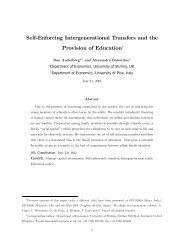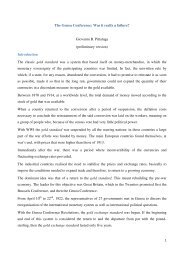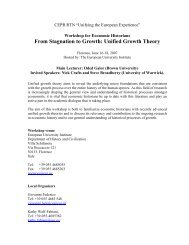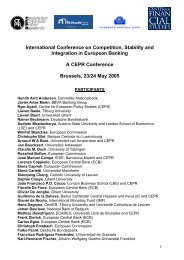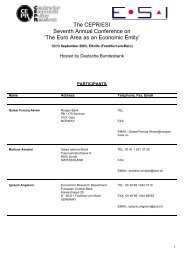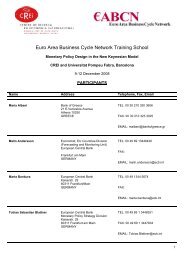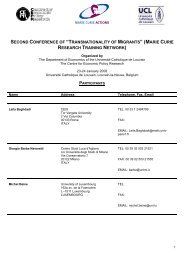MARKET STRUCTURE AND ENTRY: WHERE'S THE BEEF? - CEPR
MARKET STRUCTURE AND ENTRY: WHERE'S THE BEEF? - CEPR
MARKET STRUCTURE AND ENTRY: WHERE'S THE BEEF? - CEPR
Create successful ePaper yourself
Turn your PDF publications into a flip-book with our unique Google optimized e-Paper software.
calculate the follower’s (BK’s) expected profit from entering market j in period t when<br />
the leader (McD) has entered in that period, and when it has not. Call these estimated<br />
profits ˆ BK ˆ BK<br />
Π McD = Π (., M jt + 1)<br />
and ˆ BK ˆ BK<br />
Π noMcD = Π (., M jt ) , respectively. In the former, it<br />
is assumed that McD’s stock of outlets is one greater than it was at the beginning of the<br />
period, whereas in the latter it is equal to that at the beginning of the period. Note that we<br />
assume that a new McD outlet does not influence BK’s estimate of market size (S(.)), but<br />
only its variable profits (V(.)). We then draw R (times NT) pseudo random numbers εˆ Bjt<br />
from a standard normal, and create simulated BK entry decisions based on<br />
ˆ BK<br />
1 ( Π ˆ<br />
McD, jt + ε Bjt ≥ 0)<br />
and ˆ BK<br />
1 ( Π ˆ<br />
noMcD, jt + ε Bjt ≥ 0)<br />
, where 1(.) is an indicator function taking<br />
the value one if the statement in parenthesis is true, and the value zero otherwise. These<br />
are then added to the existing BK outlets and used in the McD likelihood function in<br />
place of actual BK outlet figures.<br />
5.3. Follower (BK) Results<br />
Before turning to the results, we point out that in all our estimations the<br />
coefficient of own outlets in S(.) was either insignificant, or carried the wrong (negative)<br />
sign. We interpreted this as a problem of identification (relative to V(.)), and therefore,<br />
excluded the variable OWNjt from S(.) in all the structural form estimations. The results<br />
for BK are reported in Table V. We have estimated the model for both firms under the<br />
assumption of a standard probit error structure, and assuming that the market-specific<br />
time-invariant error term is 1) in the market size function S(.), and 2) part of the fixed<br />
costs of entry. The first set are estimated using ML for BK (the follower) and MSL for<br />
McD (the leader), the latter two using MSL with R=40 and antithetics.<br />
Looking first at column (1) that contains the standard probit results for BK, we<br />
25



